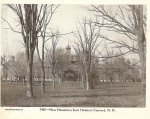Difference between revisions of "Portal:Featured Article Of The Week"
M-Explorer (talk | contribs) |
M-Explorer (talk | contribs) |
||
| Line 1: | Line 1: | ||
{{FAformat | {{FAformat | ||
| − | |Title= | + | |Title= Concord State Hospital |
| − | |Image= | + | |Image= Concord4.jpg |
|Width= 150px | |Width= 150px | ||
| − | |Body= | + | |Body= About the year 1830 the condition of the insane of New Hampshire began to awaken a deep interest in the hearts of philanthropic persons in all sections of the state. As the public interest in the subject deepened, a settled conviction was formed in leading minds that the state should take the initiative in whatever measures might be adopted. Influenced in part, perhaps, by this general sentiment, but feeling deeply the importance of the enterprise, Governor Dinsmore, in his message to the Legislature in June, 1832, thus called attention to the condition of the insane: "I feel no apology need be made, in an age so distinguished for its public and private charities, for calling your attention to a subject which has so much reason and humanity on its side as a measure for the security and recovery of the lunatic or insane. The Legislature of the state has never yet recognized these unfortunate beings as entitled to any special favor from the government." |
| − | + | He also recommended, as a preparatory step, the institution of an inquiry: "To ascertain, with as much exactness as practicable, the whole number of insane within the state, distinguishing paupers from others, the number which have been committed to jail within a given time by authority of court, or by their friends or others, without the order or sanction of judicial proceedings, and the length of their respective terms of confinement; and to ascertain, in like manner, the actual or probable amount of cost of court and jailers' fees, and expenses of their support and maintenance in cases of confinement." | |
| + | |||
| + | In accordance with this recommendation, the Governor was directed "To take proper means to ascertain the number of insane persons in the state." [[Concord State Hospital|Click here for more...]] | ||
}} | }} | ||
Revision as of 05:26, 14 January 2013
Featured Article Of The Week
Concord State Hospital
About the year 1830 the condition of the insane of New Hampshire began to awaken a deep interest in the hearts of philanthropic persons in all sections of the state. As the public interest in the subject deepened, a settled conviction was formed in leading minds that the state should take the initiative in whatever measures might be adopted. Influenced in part, perhaps, by this general sentiment, but feeling deeply the importance of the enterprise, Governor Dinsmore, in his message to the Legislature in June, 1832, thus called attention to the condition of the insane: "I feel no apology need be made, in an age so distinguished for its public and private charities, for calling your attention to a subject which has so much reason and humanity on its side as a measure for the security and recovery of the lunatic or insane. The Legislature of the state has never yet recognized these unfortunate beings as entitled to any special favor from the government."
He also recommended, as a preparatory step, the institution of an inquiry: "To ascertain, with as much exactness as practicable, the whole number of insane within the state, distinguishing paupers from others, the number which have been committed to jail within a given time by authority of court, or by their friends or others, without the order or sanction of judicial proceedings, and the length of their respective terms of confinement; and to ascertain, in like manner, the actual or probable amount of cost of court and jailers' fees, and expenses of their support and maintenance in cases of confinement."
In accordance with this recommendation, the Governor was directed "To take proper means to ascertain the number of insane persons in the state." Click here for more...
